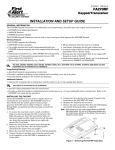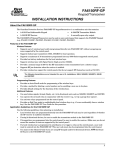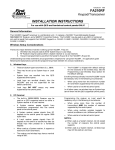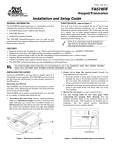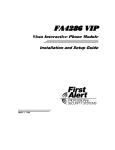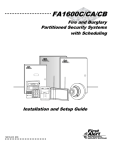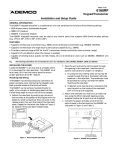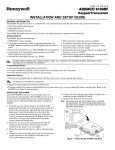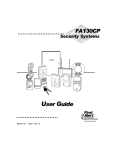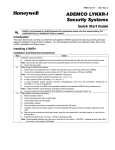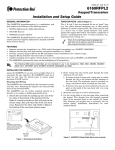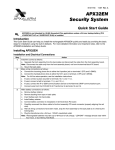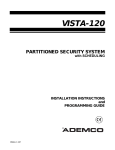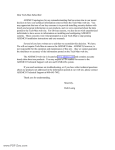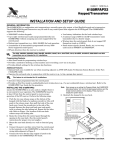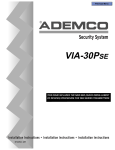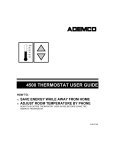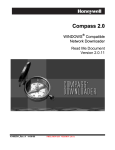Download FA260RF INSTALLATION INSTRUCTIONS UL
Transcript
K4456V1 8/00
FA260RF
Keypad/Transceiver
INSTALLATION INSTRUCTIONS
About the FA260RF
The FA260RF is a combination unit that contains:
•
A FA260KP Fixed Addressable Keypad
•
A 5800TM Transmitter Module
•
A 5881M RF Receiver
•
A normally-open relay output.
The FA260RF Keypad/Transceiver may be used on any control panel that supports the FA260KP Keypad (e.g.,
FA110C, FA120C, FA142C, FA148C, FA162C, FA1220CV, FA1340C, FA1600CA).
Features of the FA260RF
Wireless Features
UL
The following transmitters are not intended for use in UL installations: 5804, 5804BD, 5804BDV, 5804E,
and 5827BD.
•
Supports up to 8 wireless keys locally (programmed directly into FA260RF) without occupying any zones
supported by the control panel.
•
Supports button-type transmitters (5804, 5804BD) for local operation.
•
Supports a maximum of 16 transmitters programmed into any 5800 Series-supported control panel.
•
Annunciates low-battery indications for the local wireless keys.
•
Supports wireless keys with Signal Sentry (high-security) (5804E).
•
Provides a nominal range of 200' for the RF transmitters (some transmitters have a shorter range).
•
Supports RF jam detection when the receiver is enabled.
•
Provides wireless key support for control panels that do not support RF themselves (FA110C).
Programming Features
•
Provides an Auto Enroll mode for programming of the wireless keys.
•
Provides a method for deleting a serial number and re-enrolling a new one in its place.
•
Provides default settings for the functions of the wireless keys.
Additional Features
•
•
•
•
•
Provides tamper protection that causes the system to annunciate a trouble condition if the cover is removed
or the unit is removed from the wall. (If supported by the control panel). The tamper switch has not been
evaluated for UL installation.
Can send status signals (Armed, Ready, etc.) to bi-directional units such as 5804BD, 5804BDV and 5827BD.
Can operate the on-board relay in conjunction with the receiver (e.g., to trip a garage door opener).
Can activate relays programmed into the control panel.
Provides an End User mode to enable/disable local wireless keys (e.g., if a user accidentally loses a wireless
key). See the User Guide for the procedure.
Application Guidelines for the FA260RF
Use the following guidelines when planning an installation:
•
•
•
•
Local wireless keys are programmed directly into the FA260RF and may be used regardless of whether the
RF receiver is enabled or disabled.
If using bi-directional devices, be sure to enable the transmitter module in the FA260RF.
If transmitters are programmed into the control panel, be sure to enable the receiver. (Make sure you do not
exceed the number of receivers the control panel supports.)
If a local wireless key is programmed to arm/disarm or to trigger a relay on the control panel, a user code
must be entered into the FA260RF. This user code must also be programmed into the control panel.
•
You must set the House ID only if you are using RF keypads and/or bi-directional devices; AND the House
ID Source is the FA260RF (Local).
FA260RF Application Guide
Below is a guide that outlines how to program the wireless keys, RF receiver, and the House ID in the FA260RF
for your particular installation.
Control Panel
Are you using
RF keys beyond
system’s
capacity?
RF receivers
beyond system’s
capacity?
RF keypads and/or
Bi-directional
devices on more
than 1 partition?
FA110C, FA120C
N/A
N/A
N/A
Local
FA142C, FA148C
NO
YES
YES
NO
NO
YES
N/A
N/A
N/A
Use Programming Without Local Wireless Keys
Local
Enable [1]
System [1]
Local
Disable [0]
Local [0]
FA162C
NO
YES
YES
NO
YES
NO
NO
YES
YES
YES
NO
NO
NO
YES*
YES*
Use Programming Without Local Wireless Keys
Local
Enable [1]
System [1]
Local
Disable [0]
Local [0]
System
Disable [0]
Local [0]
Local
Disable [0]
Local [0]
FA1220CV,
FA1340C,
FA1600CA
NO
YES
YES
NO
YES
NO
NO
YES
YES
YES
NO**
NO**
NO**
YES
YES
Use Programming Without Local Wireless Keys
Local
Enable [1]
System [1]
Local
Disable [0]
Local [0]
System
Disable [0]
Local [0]
Local
Disable [0]
Local [0]
Program
Wireless Keys
As
Program
RF
Receiver
Disable
House ID
Source***
As
Local [0]
* Two FA260RFs are needed for this application. One connected to partition 1’s keypad terminals and one connected to partition 2’s.
** If using an RF keypad on only one partition, the FA260RF’s partition assignment must match the partition set in field 1*48.
*** If set for Local on a partition control, the FA260RF’s partition assignment must match the partition programmed in the BD device.
Installing the FA260RF
Locate the FA260RF in an area and at a height where it is convenient for users to operate the system. The
FA260RF must be at least 10' from the control panel to ensure proper operation of the RF receiver.
To install the FA260RF, refer to Figure 1 for wiring
connections and perform the following steps:
Step
1
C +
NO
3
D +
_
4
+
+
2
+
+ +
DO
TAMPER
SWITCH
5
6
7
Figure 1: FA260RF Wiring Connections
2
Action
Remove the case back by pushing down
the two snaps along the FA260RF’s
bottom edge and pulling the case apart.
Route the wiring from the control panel
through the opening in the case back.
(See the control panel’s instructions for
proper wire run lengths.)
Mount the case back directly to a wall or
electrical gang box.
Connect the power and data wires from
the control panel to the terminals on the
FA260RF.
Connect the wires for the relay output (if
being used) to the terminals on the
FA260RF’s PC board.
Reattach the keypad to its case back.
Remove the clear protective films from
the LCD display and install the keypad
labels, as required.
NOTE: Upon power up or exit of the Program
mode, the FA260RF alternately flashes "Ad" and the
2-digit keypad address and the 2-digit receiver
address on the display. Press any key to display the
system status.
FA260RF Programming
The FA260RF is shipped with pre-programmed default values. Below is a chart showing these values. Later in
these instructions are diagrams showing the wireless keys' loops and their default functions. Regardless of
which wireless key you use (even if it is one not shown), loops 1-4 are defaulted for all 8 devices as shown.
These values may be changed to suit the installation.
Entering Program Mode
Press the [1] and [3] keys simultaneously for a few seconds within 30 seconds after applying power or within 30
seconds after removing the case back. The keypad beeps 3 times, and two dashes and two zeroes flash
alternately in the upper left-hand corner of the display. If any other numbers or letters flash in the display,
press the [✳] key.
Pressing the [1] and [3] keys 30 seconds or more after applying power allows you to enter the User mode.
This mode provides a means to enable and disable individual local wireless keys (useful if, e.g., a user
accidentally loses a wireless key). See the User Guide for procedure instructions.
Programming Operations
Once you have entered the Program mode, you may move to any program address simply by entering the
program address number. The FA260RF will automatically exit the Program mode if no keys are pressed for 30
seconds. While in the Program mode:
•
Pressing the [✳] key stores the information displayed, then moves you to the next prompt, and the keypad
beeps twice.
•
Pressing the [#] key erases the current information and moves you back so you may enter the correct
information.
Enter a program address (e.g., press [1] for Keypad Address; [2] for Receiver Address) to set the parameters in
the FA260RF. The following chart lists the program addresses, the keypad display and the choices.
Program
Address
Description
Display
Choices
Default
1
Keypad Address
cA
01-31
31
2
Receiver Address
rA
00-30
00
3
House ID
hI
01-31
4
House ID Source
hS
5
Wireless Key Editing
d-
6
Receiver Enable
r-
1 = System
0 = Local
Enter Existing Device
Number
1 = On 0 = Off
1 Enable
Transmitter Module Enable
tE
1 = On 0 = Off
1 Enable
8
Wireless Key Auto Enroll
d-
Enter Serial Number
8 then 2
Wireless Key User Code
u4
Enter 4-Digit User Code
8 then 4
Wireless Key Loop Function
Ln
Enter Loop Number then
Function (See Wireless
Key Function Chart)
8 then 5
Wireless Key On-Board
Relay Assignment
o-
Enter Loop Number then
Relay Action
9
Restore Defaults
EE
0
*High-Security Mode
En
1 = Restores Defaults
Any Other Key = Does
Not Restore Defaults
1 = Enable; 0 = Disable
7
1 System
Loop 2
Loop 3
Loop 4
Loop 1
1 (Disarm)
2 (Arm Away)
3 (Arm Stay)
Close for 2
Seconds
0 Disable
* When operating the system in High-Security mode, non-encrypted wireless keys will still function. If you
want only the encrypted wireless keys to operate, be sure to delete all non-encrypted keys from the
system.
3
Defaulting the FA260RF
To restore the FA260RF to the default values, perform the following steps:
Step
Action
1
Enter the Program mode by pressing the [1] and [3] keys simultaneously for a few seconds within 30
seconds after applying power. The keypad alternately flashes “00” and two dashes.
2
Press the [9] key. The display flashes “EE.”
3
Press the [1] key to restore the default values, or press any other key to exit without restoring the
default values.
If you pressed [1], the keypad beeps 3 times and returns to alternately flashing “00” and two dashes.
If you pressed any other key, the keypad does not beep, and returns to alternately flashing “00” and
two dashes.
4
Press [✳] to exit the FA260RF Program Mode.
Programming Procedure
This section is divided into two parts.
•
Programming for an installation WITHOUT local wireless keys.
•
Programming for an installation WITH local wireless keys.
Using this programming procedure is necessary only if you plan to use wireless keys beyond the control
panel’s capacity, or on a system that does not support 5800 Series wireless. Refer to the FA260RF
Application Guide on page 2 for installations that require these settings.
Note: See the control panel's installation instructions for the acceptable keypad and receiver addresses.
•
•
If you are using a wireless key in High-Security mode (5804E) in the control panel, it will occupy one
of the devices in the FA260RF.
When operating the system in High-Security mode, non-encrypted wireless keys will still function. If
you want only the encrypted keys to operate, be sure to delete all non-encrypted keys from the
system.
Programming for an Installation WITHOUT Local Wireless Keys
To program the FA260RF for an installation without any local wireless keys, perform the following steps:
Step
Action
Display
1
Enter the Program mode by pressing the [1] and [3] keys
simultaneously for a few seconds within 30 seconds after applying
power or within 30 seconds after removing the case back.
Alternately flashes "oo" and
two dashes.
2
Enter [1] (Keypad Address). Enter the 2-digit keypad address (0131). Press the [✳] key to continue.
Alternately flashes "cA" and
the 2-digit keypad address.
3
Enter [2] (Receiver Address). Enter the 2-digit receiver address (0030). Press the [✳] key to continue.
Alternately flashes “rA” and
the 2-digit receiver address.
4
Enter [4] (House ID Source). Enter [1] (System) to use the House ID
programmed into the control panel, if RF keypad(s) and/or bidirectional device(s):
• Are used on the control panel.
Alternately flashes “hl” and
either "1" or "0."
OR
• Neither is used.
Enter [0] (Local) to use the House ID programmed into the
FA260RF (Program Address 3).
Note: If the House ID Source is:
• System (1), RF keypad and bi-directional units MUST
match the House ID programmed into the control panel.
• Local (0), RF keypad and bi-directional units MUST
match the House ID programmed into the FA260RF.
Press the [✳] key to continue.
4
Step
Action
Display
5
Enter [6] (Receiver Enable). Enter [1] to enable, or [0] to disable.
Enable the receiver if RF transmitters or wireless keypads are
programmed into the control.
Note: Make sure the number of receivers set for Enable (1) does not
exceed the capacity of the control panel.
Press the [✳] key to continue.
Enter [7] (Transmitter Module Enable). Enter [1] to enable, or [0] to
disable. Enter [1] if bi-directional devices are being used.
Note: If the House ID Source is System and more than one FA260RF
is used, make sure only one has the Transmitter Module
enabled. See Note under House ID Source step 4.
Press the [✳] key.
Enter [0] (High-Security Mode). To put the system into HighSecurity mode, enter [1]. Enter [0] to disable.
Press the [✳] key to exit the FA260RF Program mode.
Alternately flashes “r-” and
either "1" or "0."
6
7
8
Alternately flashes “tE” and
either "1" or "0."
En
“READY” or “NOT READY”
Note: This is all the FA260RF programming necessary for this application. Upon exiting the Program mode,
the FA260RF alternately flashes "Ad," the 2-digit keypad address, and the 2-digit receiver address. If
either of these is incorrect, repeat steps 1 through 3.
Programming for an Installation WITH Local Wireless Keys
•
•
The FA260RF is supplied with default settings for the functions of the wireless keys. See page 3.
If, during the programming of the wireless keys, you make a wrong entry and want to reprogram a
wireless key, simply press the [✳] key until “d-“ is displayed. Then enter the correct information.
Perform steps 1-6 in the Programming for an Installation Without Local Wireless Keys section. Then perform
the following steps:
Step
Action
Display
1
2
3
4
5
Enter [3] (House ID). Enter the 2-digit House ID for the FA260RF
(01-31).
Note: The House ID is needed only if RF keypads and/or bidirectional units are used and House ID source is set for Local.
The House ID entered here MUST match the House ID
programmed in the RF keypad and the bi-directional unit.
Press the [✳] key to continue.
Enter [8] (Wireless Key Auto Enroll). The FA260RF automatically
advances to first available device number.
Note: If all 8 devices have been enrolled, the FA260RF beeps three
times and continues to alternately flash "oo" and "--."
Press any button on the wireless key to enroll the serial number.
Note: If enrolling a wireless key (5804E) in High-Security mode,
press all four buttons on the wireless key simultaneously.
Press the [✳] key to accept the serial number; OR press the [#] key
to reject the serial number.
If you accept the serial number, the FA260RF beeps twice. If you
reject the serial number, the FA260RF returns to the “enroll serial
number” prompt.
Note: A maximum of 8 wireless keys may be enrolled into the
FA260RF. These wireless keys DO NOT occupy any zones
supported by the control.
If you are finished programming for now, press [✳] to exit.
Otherwise, continue with step 5.
Enter [2] (User Code). Enter the 4-digit user code for the wireless
key.
Note: The user code must be a valid code that is programmed in the
control panel.
Press the [✳] key to accept the user code.
If you are finished programming for now, press [✳] to exit.
Alternately flashes “hl” and a
2-digit number.
Alternately flashes "d" with
the device number; and “--.”
Alternately flashes "d" with
the device number; and the
serial number.
If you accept the serial
number, the display flashes
the device number and a
hyphen.
If you reject the serial
number, the display
alternately flashes "d" with
the device number; and “--.”
Flashes "u4." Once the 4-digit
user code is entered, the
display flashes "u4," the first
two digits, and then the last
two digits of the user code.
5
Otherwise, continue with step 6.
Step
Action
Display
6
Enter [4] (Loop Functions). Enter the loop number (1-4).
Note: The FA260RF is shipped with the loop functions preprogrammed. Perform steps 6 through 10 only if it is necessary
to change any of the loop functions.
Loop 1 Close the FA260RF On-Board Relay for 2 sec.
Loop 2 1 (Disarm)
Loop 3 2 (Arm Away)
Loop 4 3 (Arm Stay)
See the Wireless Key Function Chart below for the choices.
Wireless Key Function Chart
Flashes "Ln."
Entry
Disarming
1
Arming Away
2
Arming Stay
3
Arming Maximum (Away Instant)
4
Arming Instant
7
Panic Alarm
Produces type of alarm [* & #]
programmed in control panel.
Manually Start a Relay Action
# + 99
Manually Stop a Relay Action
Activate Relay as Programmed in
Control
Activate Relay as Programmed in
Control
Activate Access Control Relay for
Partition
# + 7 (FA142C)
# + 7 + n (FA162C)
Default Loop Functions
Loop 3
Arm AWAY
Loop 2
Disarm
Loop 4
Arm STAY
Loop 1
Close on-board relay
for 2 seconds
5804
Loop 2
Disarm
Loop 4
Arm STAY
Loop 3
Arm AWAY
Loop 1
Close on-board relay
for 2 seconds
••
•
••
Function
Once the loop number is
entered, alternately flashes
"L" with the loop number and
the present function.
••
• • ••
• •• • ••
••
# + 8 (FA142C)
# + 8 + n (FA162C)
# + 71 (FA1220C, FA1220CV,
FA1340C)
# + 72 (FA1220C, FA1220CV,
FA1340C)
0 FA1220C, FA1220CV,
FA1340C)
SET
HOUSE
CODE
5 8 0 4 B D / 5 8 0 4 B DV
n = Device Number programmed in FA162C to be controlled
Press the [✳] key.
7
Repeat step 6 for the rest of the loops of the wireless key.
8
To program a button on the wireless key to control the on-board
relay, enter [5] (On-Board Relay Assignment).
Flashes "o-."
9
Enter the loop number of the wireless key (1-4). Enter the relay
action (0 = no action; 1 = relay off; 2 = relay on; 3 = relay toggles on
and off; 4 = relay closes for 2 seconds).
Flashes “o” and the loop
number.
Once the action is entered,
displays “o” and alternately
flashes the loop number and
the relay action.
Note: The relay action must be "0" for UL installations.
Press the [✳] key.
10
Repeat step 9 for the rest of the loops.
11
When all loops have been programmed for the wireless key, press
the [✳] key.
12
The FA260RF automatically displays the next available device
number (one that does not have a serial number).
If you want to program additional wireless keys, repeat steps 3
through 10. Otherwise, press the [#] key. This takes you back to the
main display, which alternately flashes “oo” and “- -.”
Enter [0] (High-Security Mode). To put the system into HighSecurity mode, enter [1]. Enter [0] to disable
Press [✳] to exit the FA260RF Program mode.
13
14
Note:
6
Flashes “d” followed by the
device number.
En
Upon exiting the Program mode, the FA260RF alternately flashes "Ad," the 2-digit keypad address, and
the 2-digit receiver address. If either of these is incorrect, repeat steps 1 through 3 in the
Programming for an Installation Without Local Wireless Keys section.
Deleting, Replacing, or Editing Wireless Keys
Use the following procedure to delete, replace, or change any of the programming for a wireless key.
Step
Action
Display
1
Enter the program mode by pressing the [1] and [3] keys
simultaneously for a few seconds within 30 seconds after applying
power.
Alternately flashes "oo" and
two dashes.
2
Enter [5] (Wireless Key Editing). Enter the device number for the
wireless key you want to edit. This must be a device that has its
serial number programmed in the FA260RF already.
To delete the serial number, press [✳], then press [9], then press [✳]
again.
To exit without deleting the serial number, press the [#] key
Press the [✳] key to continue.
To change any of the programming for the wireless key, perform one
of the following step in the Programming for an Installation WITH
Local Wireless Keys section.
•
For the user code, perform step 5.
•
For the loop functions, perform steps 6 and 7.
•
For the on-board relay assignment, perform steps 8 to 9.
When you have completed editing the wireless keys, press the [✳]
key twice to exit the Program mode.
Flashes the device number
and a hyphen.
3
4
Note:
Once the device number is
entered, alternately flashes
"d" with the device number
and the serial number.
Alternately flashes "d" with
the device number; and “--.”
Upon exiting the Program mode, the FA260RF alternately flashes "Ad," the 2-digit keypad address, and
the 2-digit receiver address. If either of these is incorrect, repeat steps 1 through 3 in the
Programming for an Installation Without Local Wireless Keys section.
Troubleshooting
The following error messages cause the FA260RF to produce rapid beeps for 5 seconds. The table below
describes the error messages and the corrective actions.
Display
Probable Cause
Corrective Action
Lb
Low battery in the wireless
key
1.
OC
Open circuit
1C
Incompatible connection
Check 09
1.
2.
FA260RF Receiver is
not communicating
Another device on the
keypad terminals is
not communicating to
the control panel
Replace the battery if the wireless key has a replaceable
battery.
2. Replace the transmitter if the wireless key does not have a
replaceable battery.
Verify that the Data Out (DO) wire is connected properly.
Verify that the control panel is not An ADEMCO-type control
panel.
1. Verify that the Data In (DI) wire is connected properly.
2.
Verify the wiring connections between the control and all
other devices.
Specifications
Physical:
6-9/16” H x 4-7/8” W x 1-1/4” D
(166.68mm x 123mm x 31.75mm)
Wiring:
(+)
(-)
DO
DI
Range:
200' nominal
+12VDC
Ground
“Data out” from Control Panel
“Data in” to Control Panel
Frequency: 345 MHz
Standby
105mA
Current:
Backlighting on and
Sounder on
175mA
Normally Open, 1A, 28VDC
Relay:
Sounder:
Speaker (fire alarm is loud pulsing tone;
burglary/audible panic alarm is
continuous tone)
7
FOR DETAILS ON THE LIMITATIONS OF THE ENTIRE ALARM SYSTEM, REFER TO THE INSTALLATION
INSTRUCTIONS FOR THE CONTROL PANEL WITH WHICH THIS DEVICE IS USED.
FCC STATEMENT
This device complies with Part 15 of the FCC rules. Operation is subject to the following two conditions: (1) This device may not cause harmful interference,
and (2) This device must accept any interference received, including interference that may cause undesired operation.
FCC ID.CFS8DLFA260RF
FEDERAL COMMUNICATIONS COMMISSION (FCC) Part 15 STATEMENT
This equipment has been tested to FCC requirements and has been found acceptable for use. The FCC requires the following statement for your information:
This equipment generates and uses radio frequency energy and if not installed and used properly, that is, in strict accordance with the manufacturer's
instructions, may cause interference to radio and television reception. It has been type tested and found to comply with the limits for a Class B computing
device in accordance with the specifications in Part 15 of FCC Rules, which are designed to provide reasonable protection against such interference in a
residential installation. However, there is no guarantee that interference will not occur in a particular installation. If this equipment does cause interference to
radio or television reception, which can be determined by turning the equipment off and on, the user is encouraged to try to correct the interference by one or
more of the following measures:
•
If using an indoor antenna, have a quality outdoor antenna installed.
•
Reorient the receiving antenna until interference is reduced or eliminated.
•
Move the radio or television receiver away from the receiver/control.
•
Move the antenna leads away from any wire runs to the receiver/control.
•
Plug the receiver/control into a different outlet so that it and the radio or television receiver are on different branch circuits.
If necessary, the user should consult the dealer or an experienced radio/television technician for additional suggestions. The user or installer may find the
following booklet prepared by the Federal Communications Commission helpful: "Interference Handbook"
This booklet is available from the U.S. Government Printing Office, Washington, DC 20402.
The user shall not make any changes or modifications to the equipment unless authorized by the Installation Instructions or User's Manual. Unauthorized
changes or modifications could void the user's authority to operate the equipment.
LIMITED WARRANTY
Pittway Corporation, and its divisions, subsidiaries and affiliates ("Seller"), 165 Eileen Way, Syosset, New York 11791,
warrants itsFirst Alert products to be in conformance with its own plans and specifications and to be free from defects in
materials and workmanship under normal use and service for 36 months from the date stamp control on the product or,
for products not having a date stamp, for 30 months from date of original purchase unless the installation instructions or
catalog sets forth a shorter period, in which case the shorter period shall apply. Seller's obligation shall be limited to
repairing or replacing, at its option, free of charge for materials or labor, any product which is proved not in compliance
with Seller's specifications or proves defective in materials or workmanship under normal use and service. Seller shall
have no obligation under this Limited Warranty or otherwise if the product is altered or improperly repaired or serviced
by anyone other than First Alert factory service. For warranty service, return product transportation prepaid, to First
Alert Factory Service, 170 Michael Drive, Syosset, New York 11791.
THERE ARE NO WARRANTIES, EXPRESS OR IMPLIED, OF MERCHANTABILITY, OR FITNESS FOR A
PARTICULAR PURPOSE OR OTHERWISE, WHICH EXTEND BEYOND THE DESCRIPTION ON THE FACE
HEREOF. IN NO CASE SHALL SELLER BE LIABLE TO ANYONE FOR ANY CONSEQUENTIAL OR INCIDENTAL
DAMAGES FOR BREACH OF THIS OR ANY OTHER WARRANTY, EXPRESS OR IMPLIED, OR UPON ANY OTHER
BASIS OF LIABILITY WHATSOEVER, EVEN IF THE LOSS OR DAMAGE IS CAUSED BY THE SELLER'S OWN
NEGLIGENCE OR FAULT.
Seller does not represent that the products it sells may not be compromised or circumvented; that the products will
prevent any personal injury or property loss by burglary, robbery, fire or otherwise; or that the products will in all cases
provide adequate warning or protection. Customer understands that a properly installed and maintained alarm may
only reduce the risk of a burglary, robbery, fire or other events occurring without providing an alarm, but it is not
insurance or a guarantee that such will not occur or that there will be no personal injury or property loss as a result.
CONSEQUENTLY, SELLER SHALL HAVE NO LIABILITY FOR ANY PERSONAL INJURY, PROPERTY DAMAGE
OR OTHER LOSS BASED ON A CLAIM THE PRODUCT FAILED TO GIVE WARNING. HOWEVER, IF SELLER IS
HELD LIABLE, WHETHER DIRECTLY OR INDIRECTLY, FOR ANY LOSS OR DAMAGE ARISING UNDER THIS
LIMITED WARRANTY OR OTHERWISE, REGARDLESS OF CAUSE OR ORIGIN, SELLER'S MAXIMUM LIABILITY
SHALL NOT IN ANY CASE EXCEED THE PURCHASE PRICE OF THE PRODUCT, WHICH SHALL BE THE
COMPLETE AND EXCLUSIVE REMEDY AGAINST SELLER. This warranty replaces any previous warranties and is
the only warranty made by Seller on this product. No increase or alteration, written or verbal, of the obligations of this
Limited Warranty is authorized.
175 Eileen Way, Syosset, NY 11791
Copyright 2000 PITTWAY CORPORATION
¬.9?l
K4456V1 8/00








